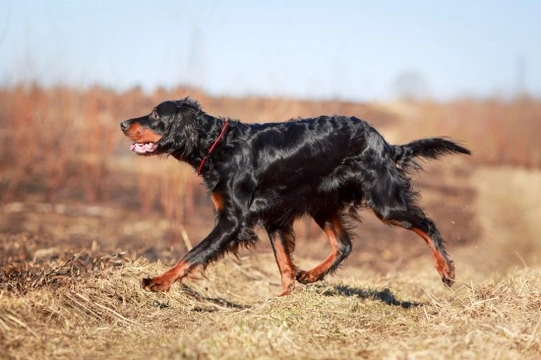
Gordon setter hereditary health and longevity
The Gordon setter is the heftiest of all of the setter dog breeds, and is a large, heavy and handsome dog that stands up to 27” tall at the withers, and can weigh up to 36kg. Males of the breed tend to be larger than females. Originally bred to hunt for game birds with shooting parties, today, the Gordon setter can still be seen in some areas as a working dog, but they are more commonly owned as pets.
The breed is also sometimes known as the black and tan setter, and their coats are glossy and black in the main part, with points and markings in either chestnut or mahogany. A little white may be present on the chest too. Occasionally, a recessive gene for a red coat can present itself within the breed, leading to red Gordon setters being born to black and tan parents. However, this colour variant is not considered to be acceptable under the breed standard. The coat of the Gordon setter is long and silky smooth, and can be either straight or slightly wavy. They have longer hair and feathering on the legs, tail and chest.
If you are considering buying or adopting one of these handsome dogs, it is of course vital to do plenty of research into the breed before committing to a purchase. In this article we will look at the hereditary health and genetic diversity of the breed in more detail, to help you to make a decision on a potential purchase.
Gordon setter longevity
The average life expectancy for the Gordon setter breed as a whole is 10-12 years, which is around the low to average figure across the board for all breeds of a similar size.
Gordon setter conformation
The Gordon setter is a large, muscular and relatively heavyweight dog, which places them at a slightly higher risk of certain health conditions that can be caused in part due to this conformation.
- The breed is one that is at potential risk of bloat or GDV, an acute condition that causes the stomach to fill with gas and potentially flip over on itself. This condition can be fatal without prompt treatment.
- The shape of the eyes too can place the breed at risk of medial canthal pocket syndrome, in which the shape of the eyelids forms pouches that can permit dirt and debris to accumulate within the eye.
- Due to the slow physical development of the breed, breed clubs also advise that only bitches aged 21 months or older be used for breeding.
Genetic diversity
The coefficient of inbreeding statistic for the Gordon setter is 7.6%, which is slightly higher than the accepted ideal of 6.25% or lower. This means that breeders of Gordon setters should take special care to reduce the coefficient of inbreeding statistic within their own breed lines where possible.
Health testing
The Gordon setter breed is known to be at risk of certain hereditary health problems, and many of these can be tested or screened for prior to breeding. Currently, screening programmes and tests are available for the following conditions:
- Hip score testing, with the mean score for the breed being 14.5. Parent dogs should receive a hip score lower than this in order to be considered for breeding.
- Elbow dysplasia, with the ideal score being zero.
- Testing for a rod-cone deficiency of the eyes, the RDC4 mutation. This condition leads to progressive retinal atrophy, and as many as 50% of all dogs of the breed may be carriers for this mutation.
- Cerebellar degeneration testing is also possible, but this test is run by an American organisation and so needs to be specially requested.
Other health issues
As well as the testable conditions outlined above, the breed is also considered to have risk factors for various other conditions that may have a hereditary factor to them. These include:
- Onychodystrophy, a condition that causes the claws to be weak and prone to flaking and splitting.
- Atopy, a hypersensitivity to certain protein particles, including pollen. This can lead to intense itching of the skin, and may cause the dog to scratch their skin raw in an attempt to gain relief.
- Squamous cell carcinoma, a specific type of cancer that affects the nail beds.
- Juvenile cellulitis, a condition that causes inflammation of the body’s cells, and most commonly affects the skin cells. This condition presents itself in some young dogs of the breed.
- Cerebellar degeneration, a progressive disorder that leads to body tremors and generalised weakness.
- Lethal astrocytosis, a rare but usually fatal neurological condition that generally affects younger dogs of the breed.
In order to gather a full picture of health before making a purchase, it is wise to try to find out about the health of the parent dogs and grandparents dogs on both sides of the breed line, to try to ascertain a predisposition to any of these potential health issues.



